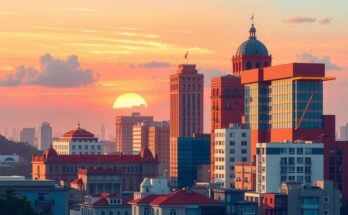Saudi Arabia is making significant investments in tourism to diversify its oil-dependent economy, yet major projects like NEOM are facing challenges related to cost overrun and viability. There are concerns about financial management, and the path forward raises questions about the sustainability of these initiatives. The future of Saudi Arabia’s tourism ambitions remains uncertain amid these challenges.
Saudi Arabia is undertaking a monumental investment in tourism, aiming to transition its economy away from oil dependency. This unprecedented financial commitment raises questions about its potential success and whether it will lead to significant non-religious international tourism, or result in a series of abandoned projects. While signs of challenges have emerged, Saudi Arabia continues to pursue its ambitious projects, including NEOM, which serves as a focal point of interest regarding these initiatives.
The Wall Street Journal’s article titled “What Went Wrong at Saudi Arabia’s Futuristic Metropolis in the Desert” examines the NEOM project, highlighting rising costs and concerns regarding its feasibility. It suggests that the project’s financial management has not been transparent, evidenced by internal audits and employee interviews. Despite these claims, project representatives argue that any inaccuracies have been misinterpreted, stating that NEOM endeavors to uphold excellence in all endeavors.
The official launch of Sindalah, a project within NEOM, occurred in October 2024, costing $45 million with an attendance of A-list celebrities. However, it was notably delayed and over budget, exhibiting unfinished hotels and ongoing construction. The public no-show of the crown prince at this event was perceived as a sign of dissent, followed by the resignation of NEOM’s director shortly after.
An internal audit purportedly revealed evidence of financial manipulation by specific management members. Notably, McKinsey & Co. has been an advisor on the project, receiving fees exceeding $130 million in a single year. NEOM’s grand plans include projected completion by 2080 at a staggering cost of $8.8 trillion, raising skepticism about its sustainability given it exceeds the annual budget of Saudi Arabia by over 25 times.
While the Vision 2030 initiative intended for much of NEOM to be completed by 2030, it has now been characterized as a generational investment that may take decades to yield results. Architecturally, NEOM is inspired by the crown prince’s interests in video games and sci-fi films, complicating the feasibility of many designs. The project’s most intricate component, “The Line,” has notably seen revised metrics on its scale and timeline.
As NEOM progresses, it remains unclear how Saudi Arabia will manage these challenges in tourism. Questions loom regarding the possibility of continued public claims of progress, reductions in investment scope, or a complete reassessment of the strategy. With a youthful population, Saudi Arabia does possess the potential for economic diversification, but a focus on realistic areas of development may yield more sustainable outcomes than model luxury resorts.
Despite the highly luxurious Marriott Bonvoy properties in the region, anecdotal reports indicate low occupancy, raising further concerns about the demand for such high-end offerings in the area. While Saudi Arabia has ambitious plans for tourism diversification, the path forward is fraught with uncertainties and challenges that merit critical observation.
In summary, Saudi Arabia’s ambitious tourism initiatives, particularly the NEOM project, face significant challenges related to cost overruns and doubts about long-term viability. As the country navigates these hurdles, it remains to be seen whether it can successfully diversify its economy away from oil, and whether the extraordinary financial investment will yield fruitful results. The future trajectory of these projects will be pivotal in determining the sustainability and success of Saudi Arabia’s tourism vision.
Original Source: onemileatatime.com




